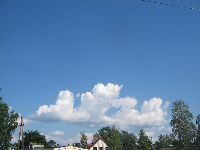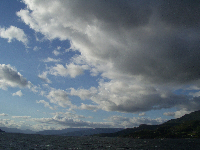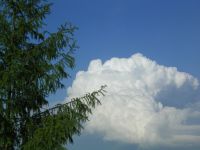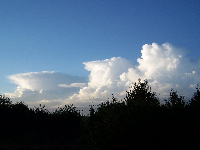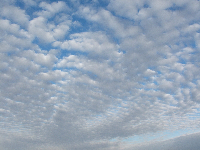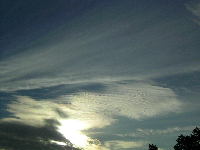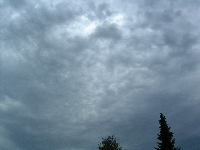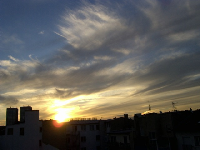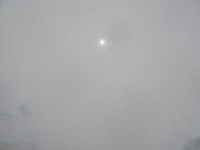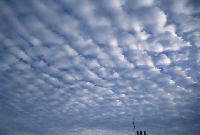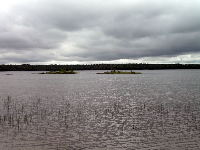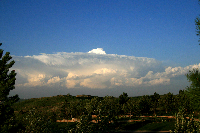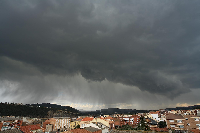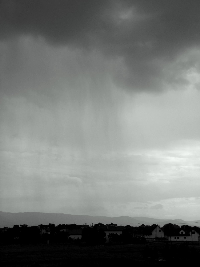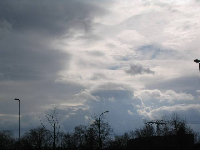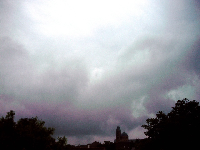Below are fourteen definitions of cloud species, grouped together by peculiarities in shape and internal structure.
Fibratus
Thin or detached clouds consisiting of nearly straight or irregulary curved filaments. Applies mainly to cirrus and cirrostratus.
Uncinus
Cirrus clouds often shaped like a comma that terminate at the top in a hook or tuft.
Spissatus
Cirrus clouds that appear grayish because of their thickness. Fair weather will persist as long as they appear in irregular patchy patterns, but if they are moving in from westerly directions they are a sign of an approaching warm front and, possibly, rain.
Castellanus
Clouds that present, in at least some portion of the their upper part proturberances in the form of turrents. The turrents are connected by a common base and seem to arrange in lines. Applies to cirrus, cirrocumulus, altocumulus, and stratocumulus.
Floccus
A cloud in which each unit is a small tuft with a cumuliform appearance, with a ragged lower part. Applies to cirrus, cirrocumulus, altocumulus, and sometimes also in stratocumulus.
Stratiformis
A horizontal sheet of clouds, applies to altocumulus, stratocumulus, and sometimes to cirrocumulus.
Nebulosus
A thin layer of clouds without distinctive characteristics. Applies mainly to cirrostratus and stratus.
Lenticularis
Clouds shaped like lenses or almonds that are occasionally iridescent. These clouds are usually orographic; however they may occur in regions with level terrain. Applies to cirrocumulus, altocumulus, and stratocumulus.
Fractus
Clouds that appear as irregular or raged shreds. Fractus clouds do not have precipitation, but may accompany precipitation clouds. Fractus clouds are generally sheared by and shredded-looking due to strong winds. Applies only to stratus and cumulus.
Humiliss
Slightly vertical cumulus clouds that generally appear flattened.
Mediocris
Moderately vertical cumulus clouds whose tops show fairly small protuberances.
Congestus
Extremly vertical cumulus clouds whose bulging upper part often resemble a cauliflower. Congestus clouds produces precipitation.
Calvus
Cumulonimbus clouds in which some protuberances on the upper part are beginning to lose their cumuliform outlines, but in which no cirriform parts can be distinguished.
Capillatus
Cumulonimbus clouds characterized by the presence of distinctly fibours or striated cirriform, often having the form of an anvil or a plume. Cumulonimbus capillatus clouds are usually accompanied by a shower or thunderstorm.
The next nine definitions, are of cloud varieties, grouped by their characteristics of organization and visibility.
Intortus
Cirrus clouds whose filaments are irregularly curved and entangled.
Vertebratus
Clouds arranged in a manner suggestive of vertebrate, ribs, or a skeleton of a fish. Applies mainly to cirrus.
Undulatus
A cloud composed of seperate or merged elements and organized in undulations. Applies mainly to cirrocumulus, cirrostratus, altocumulus, altostratus, stratocumulus, and stratus.
Radiatus
Clouds arranged in a parrallel band that seem to converge toward a point on the horizon or, when the band exrends across the sky, toward two opposite points on the horizon called radiation points. Applies mainly to cirrus, altocumulus, altostratus, stratocumulus, and cumulus.
Lacunosus
Thin cloud patches,sheets, or layers marcked by round holes with fringed edges. Applies mainly to cirrocumulus, and altocumulus, and rarely to stratocumulus.
Duplicatus
Coinciding cloud patches, sheets, or layers, sometimes partly merged at slightly different levels. Applies mainly to cirrus, cirrostratus, altocumulus, altostratus, and stratocumulus.
Translucidus
A translucent patch, sheet or layer of clouds through which the sun or moon can be seen. Applies to altocumulus, altostratus, stratocumulus, and stratus.
Perlucidus
An extensive patch, sheet or layer of clouds with well-defined but sometimes small spaces between its elements. The sun, moon, sky, or overlying clouds can be seen through the spaces. Applies to altocumulus and stratocumulus.
Opacus
An extensive patch, sheet, or layer of clouds whose greater part is sufficiently opaque to completely obscure the sun or moon. Applies to altocumulus, altostratus, stratocumulus, and stratus.
The final nine definitions, are a grouping of attached or related cloud forms called supplementary features and accessory clouds.
Incus
A cumulonimbus cloud's upper portion organized as an anvilwith either a smooth, fibrous, or striated appearance. It is a supplementary feature.
Mammatus
Hanging protuberances that look like round patches on the surface of a cloud. These supplementary features occur mostly with cirrus, cirrocumulus, altocumulus, altostratus, stratocumulus, and cumulonimbus.
Virga
Streaks of rain or ice crystals that fall from a cloudbut evaporate before reaching the ground. Applies to altocumulus, altostratus, and high-level cumuliform.
Praecipitatio
Generating precipitation that reaches the ground. This occurs with altostratus, nimbostratus, stratocumulus, stratus, cumulus, and cumulonimbus.
Arcus
A thick, horiziontal accessorycloud with ragged edges, located on the lower front part of the main cloud. Occurs with cumulonimbus and cumulus.
Tuba
A cloud column that hanges from a cloud base and, upon reaching the earth's surface, forms a tornado or waterspout. This applies to cumulonimbus and cumulus.
Pileus
A small horizontal accessory cloud, in the form of a hood, that occurs above or on top of a cumuliform cloud. Occura with cumulonimbus and cumulus.
Velum
A thin layer of accessory cloud pierced by cumuliform clouds. Occur with cumulonimbus and cumulus.
Pannus
A layer of shredded accessory clouds below the main cloud. Occurs with nimbostratus, cumulus, and cumulonimbus.




